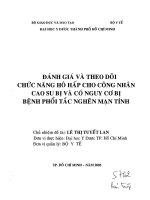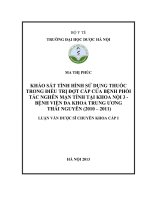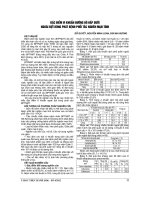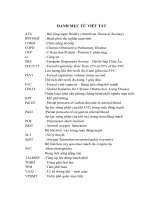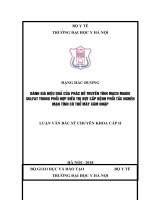NGUYÊN NHÂN VI KHUẨN GIAI ĐOẠN ĐẦU VÀ SAU ĐỢT BÙNG PHÁT BỆNH PHỔI TẮC NGHẼN MẠN TÍNH ĐƯỜNG THỞ
Bạn đang xem bản rút gọn của tài liệu. Xem và tải ngay bản đầy đủ của tài liệu tại đây (276.08 KB, 6 trang )
<span class="text_page_counter">Trang 1</span><div class="page_container" data-page="1">
<b>NGUYêN NHâN VI KHUẩN GIAI đOạN đầU và SAU ĐỢT BùNG PHáT BệNH PHổi TắC NGHẽN MạN TíNH </b>
<i><b> Đỗ Quyết</b></i>
<i><b>* </b></i>
<b>Tóm tắt </b>
Các kết quả nghiên cứu trên 40 bệnh nhân (BN) đợt bùng phát tại Bệnh viện 103 cho thấy: cấy vi khuẩn (VK) m khi m i vào viện trong t bùng phát dương tính 91,3%, trong ó hai lồi VK thư ng g p là Streptococcus pneumoniea, Moraxella catarrhalis. VK gram dương: 81%, gram âm: 19%. VK di ch r a phế quản sau t bùng phát: tỷ lệ âm tính 76,7%. Các kháng sinh cịn khá nhạy cảm v i VK m gồm: vancomycin, amociclin/clavulanic, ộ nhạy 92,3%. VK m và dịch r a phế quản kháng nhiều kháng sinh như doxyclin, amikacin, ciprofloxacin.
* Từ khóa: Bệnh phổi tắc nghẽn mạn tính; Vi khuẩn.
<b>Bacterial infection in the first stage and the end of exacerbation of chronic obstructive pulmonary disease </b>
<b>Summary </b>
<i>We have studied the bacterial characteristics of exacerbation at the beginning and the end of chronic obstructive pulmonary disease. The obtained results showed that at the beginning of exacerbation, 91.3% of bacterial culture possitive of smear sputum, the most frequent agents are Streptococcus pneumoniea, Moraxella catarrhalis, Gr (+): 81%, Gr (-): 9%. Bacterial culture of bronchoscopic sample at the end of exacerbation: 96.7% negative. Antibiotic drugs still sensible are vancomycin, amociclin/clavulanic. </i>
<i><b>* Key words: Exacerbation of chronic obstructive pulmonary disease; Bacterial infection. </b></i>
</div><span class="text_page_counter">Trang 2</span><div class="page_container" data-page="2">vi.
-
VK cho 21 BN BN
</div><span class="text_page_counter">Trang 3</span><div class="page_container" data-page="3">C BN (84,6%) : 54,5%.
<i>* : </i>
: 16 BN (40,0%); h : 26 BN (65%); h : 33 BN (82,5%); h : 16 BN (40,0%); h : 22 BN (55,5%).
<i>* (n = 30): </i>
</div><span class="text_page_counter">Trang 4</span><div class="page_container" data-page="4"><small>Kha ng sinh </small>
<small>Sè mÉu </small>
<small>Nha y (S) Ức chÕ (I) Kha ng (R) </small>
</div><span class="text_page_counter">Trang 5</span><div class="page_container" data-page="5"><i>pneumoniea là 69,5%, Moraxella. carrtahalis 14,3%, Staphylococcus. aureus 8,0%.</i>
này
: (10/17) 58,8% (2007): 81,25%
<i> Klepsilla: 21,9%, Acinetobacter: 14,6%, E. coli </i>
<i> Streptococcus.pneumoniea </i>
lin/clavulanic
eftrixone (40 - 85,7%) Streptococcus.pneumoniea
<b>ciprofloxacin 50%, Ggfloxacin 44,4%, terofloxacin 34,8%. </b>
G b -
beta-lactamase ”.
<i> Streptococcus.pneumoniae </i>
amociclin/clavulanic 6/6 (100%), c cefuroxine 3/2, cefotaxim 5/6; c VK d
VK.
</div><span class="text_page_counter">Trang 6</span><div class="page_container" data-page="6">sau:
VK 2 VK Streptococcus pneumoniea, Moraxella catarrhalis. VK gram âm: 19,%.
+ VK (76,7%), VK 7/30 (23,3%).
+ ¹ VK vancomycin, amociclin/ c y 92,3%.
VK doxyclin, amikacin, ciprofloxacin.
<b>Tµi liƯu tham kh¶o </b>
<i><b>8. Barenes PJ. Future therapies, asthma and COPD basis mechamism and Clinical management. </b></i>
Academicpress. Amsteram. 2002.
<i><b>9. O ShaughnessyT.C., AnsariTW., Barnes NC., Jeffery Pk. Inflammation in bronchial biopsies of </b></i>
subjects with chronic bronchitis: inverse relationship of CD8 + T lymphocytes FEV<small>1</small>”<small>|</small>
.<b> Am J Resp. </b>
1997.
<i>10. <b> . Pneumonies acquisesen milieu extra - Hospitallier. Infestions des voies </b></i>
respiratioires houtes et basses. Pneumologie. Pari, Epitera PIL. 1996, pp.215-225.
</div>